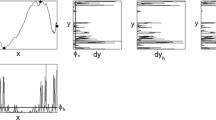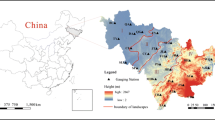Abstract
Complex geometries often present in hydrologic data sets such as precipitation records have been difficult to model in their totality using classical stochastic methods. In recent years, we have developed extensions of a deterministic procedure, the fractal-multifractal (FM) method, whose patterns share fine details and textures of individual data sets in addition to the usual key statistical properties. This work discusses our latest efforts at encoding four geometrically distinct storms gathered in Iowa City with parameters found running a modified particle swarm optimization procedure. The results reaffirm the capabilities of the FM method as all storms are closely fitted within measurement errors. All sets may be encoded with a compression ratio exceeding 350:1, have a maximum error in cumulative distribution less than 2.5 %, and closely preserve the autocorrelation, power spectrum, and multifractal spectrum of the records.
Similar content being viewed by others
References
Barnsley MF (1988) Fractals everywhere. Academic Press, San Diego
Cortis A, Puente CE, Sivakumar B (2009) Nonlinear extensions of a fractal-multifractal approach for environmental modeling. Stoch Environ Res Risk Assess 23:890–906
Cortis A, Puente CE, Huang H (2012) A physical interpretation of the deterministic fractal-multifractal method as a realization of a generalized multiplicative cascade. Stoch Environ Res Risk Assess (in preparation)
Deidda R (2000) Rainfall downscaling in a space-time multifractal framework. Water Resour Res 36(7):1779–1794
Deidda R, Benzi R, Siccardi F (1999) Multifractal modeling of anomalous scaling laws in rainfall. Water Resour Res 35(6):1853–1867
Deidda R, Badas MG, Piga E (2004) Space–time scaling in high-intensity tropical ocean global atmosphere coupled ocean–atmosphere response experiment (TOGACOARE) storms. Water Resour Res 40. doi:10.1029/2003WR002574
Deidda R, Grazia-Badas M, Piga E (2006) Space–time multifractality of remotely sensed rainfall fields. J Hydrol 322:2–13. doi:10.1016/j.jhydrol.2005.02.036
Fernández Martínez JL, García Gonzalo E, Fernández Álvarez JP, Kuzma HA, Menéndez Pérez CO (2010) PSO: a powerful algorithm to solve geophysical inverse problems. Application to a 1D-DC resistivity case. J Appl Geophys 71(1):13–25
Georgakakos KP, Carteanu AA, Sturdevant PL, Cramer JA (1994) Observation and analysis of Midwestern rain rates. J Appl Meteorol 33(12):1433–1444
Huang H, Puente CE, Cortis A, Fernández Martínez JL (2012) An effective Inversion strategy for a fractal-multifractal encoding of a storm in Boston. Submitted to J Hydrol
Langousis A, Veneziano D (2007) Intensity–duration–frequency curves from scaling representations of rainfall. Water Resour Res 43. doi:10.1029/2006WR005245
Langousis A, Veneziano D, Furcolo P, Lepore C (2009) Multifractal rainfall extremes: theoretical analysis and practical estimation. Chaos Solitons Fractals 39:1182–1194. doi:10.1016/j.chaos.2007.06.004
Lanza LG, Vuerich E, Gnecco I (2010) Analysis of highly accurate rain intensity measurements from a field test site. Adv Geosci 25:37–44
Lovejoy S, Schertzer D (1990) Multifractals, universality classes and satellite and radar measurements of cloud and rain fields. J Geophys Res 95(D3):2021–2034
Marsan D, Schertzer D, Lovejoy S (1996) Causal space–time multifractal processes: predictability and forecasting of rain fields. J Geophys Res 101(D21):26333–26346
Menabde M, Sivapalan M (2000) Modelling of rainfall time series and extremes using bounded random cascades and Levy-stable distributions. Water Resour Res 36(11):3293–3300
Menabde M, Harris D, Seed A, Austin G, Stow D (1997) Multiscaling properties of rainfall and bounded random cascades. Water Resour Res 33(12):2823–2830
Obregón N, Puente CE, Sivakumar B (2002a) Modeling high resolution rain rates via a deterministic fractal-multifractal approach. Fractals 10(3):387–394
Obregón N, Sivakumar B, Puente CE (2002b) A deterministic geometric representation of temporal rainfall. Sensitivity analysis for a storm in Boston. J Hydrol 269(3–4):224–235
Puente CE (1996) A new approach to hydrologic modeling: derived distributions revisited. J Hydrol 187:65–80
Puente CE (2004) A universe of projections: may Plato be right? Chaos Solitons Fractals 19(2):241–253
Puente CE, Obregón N (1996) A deterministic geometric representation of temporal rainfall: results for a storm in Boston. Water Resour Res 32(9):2825–2839
Puente CE, Obregón N (1999) A geometric Platonic approach to multifractality and turbulence. Fractals 7(4):403–420
Puente CE, Sivakumar B (2007) Modeling hydrologic complexity: a case for geometric determinism. Hydrol Earth Syst Sci Discuss 11:721–724
Rodríguez-Iturbe I (1986) Scale of fluctuation of rainfall models. Water Resour Res 22(9):15S–37S
Rodríguez-Iturbe I, Febres de Power B, Sharifi M, Georgakakos KP (1989) Chaos in rainfall. Water Resour Res 25(7):1667–1675
Schertzer D, Lovejoy S (1987) Physical modeling and analysis of rain and clouds by anisotropic scaling of multiplicative processes. J Geophys Res 92:9693–9714
Tessier Y, Lovejoy S, Schertzer D (1993) Universal multifractal: theory and observations for rain and clouds. J Appl Meteorol 32:223–250
Tessier Y, Lovejoy S, Hubert P, Schertzer D, Pecknold S (1996) Multifractal analysis and modeling of rainfall and river flows and scaling, causal transfer functions. J Geophys Res 101(D21):26427–26440
Veneziano D, Langousis A (2005) The areal reduction factor a multifractal analysis. Water Resour Res 41. doi:10.1029/2004WR003765
Veneziano D, Langousis A (2005b) The maximum of multifractal cascades: exact distribution and approximations. Fractals 13(4):311–324
Veneziano D, Langousis A (2010) Scaling and fractals in hydrology. In: Sivakumar B, Berndtsson R (eds) Advances in data-based approaches for hydrologic modeling and forecasting. World Scientific, Singapore
Veneziano D, Langousis A, Furcolo P (2006) Multifractality and rainfall extremes: a review. Water Resour Res 42. doi:10.1029/2005WR004716
Veneziano D, Lepore C, Langousis A, Furcolo P (2007) Marginal methods of intensity–duration–frequency estimation in scaling and nonscaling rainfall. Water Resour Res 43. doi:10.1029/2007WR006040
Veneziano D, Langousis A, Lepore C (2009) New asymptotic and pre-asymptotic results on rainfall maxima from multifractal theory. Water Resour Res 45. doi:10.1029/2009WR008257
Acknowledgments
A. Cortis’ work was supported in part by the U.S. Department of Energy under Contract No. DE-AC02-05CH11231. The reviews we received led to relevant improvements to the manuscript and they are rightly acknowledged.
Author information
Authors and Affiliations
Corresponding author
Appendices
Appendix 1
Appendix 2
The FM approach and three of its extensions. a Top left the original method: from a multifractal, bottom, to a projection, right, via a fractal interpolating function, center. b Top right an extension with overlaps and/or holes: from a multifractal, bottom, to a projection, right, via a “broken” attractor. c Bottom left, an extension with nonlinear perturbations: from a multifractal, bottom, to a projection, right, via an attractor with overlaps and holes generated with maps that contain nonlinear perturbations. d Bottom right, an extension to higher dimensions: from a multifractal, bottom, to a projection, right, of the y-marginal of an attractor in y and z
Iowa A renderings. From top to bottom, representations using the original FM approach (using three maps), the extension with overlaps and holes (four maps), the nonlinear variant of the extension (three maps), and the higher dimensional extension (three maps). Left column the fit, in black, imposed on the original data, in gray. Middle column the cumulative distributions of the data and the fit, with errors colored as area between the curves. Right column scatterplot of the data (horizontal) versus the fit (vertical). Diagonal lines indicate ±10 % lines. Readers interested in reconstructing the plots may navigate to the website, where all parameters may be found: http://puente.lawr.ucdavis.edu/omake/serra2012.html
High resolution renderings. Cumulative distributions, autocorrelation functions, and power spectra (plotted in log–log) for the four best renderings in black, imposed upon that of the original storms in gray. From top to bottom: Iowa A, B, C, D, all represented using the basic extension (Sect. 2.2) with four, three, three, and four maps
Rights and permissions
About this article
Cite this article
Huang, HH., Puente, C.E. & Cortis, A. Geometric harnessing of precipitation records: reexamining four storms from Iowa City. Stoch Environ Res Risk Assess 27, 955–968 (2013). https://doi.org/10.1007/s00477-012-0617-6
Published:
Issue Date:
DOI: https://doi.org/10.1007/s00477-012-0617-6










